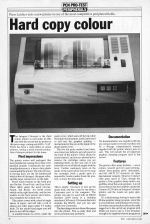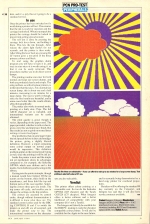
Personal Computer News
 14th January 1984
14th January 1984
Author: Piers Letcher
Published in Personal Computer News #044
Hard Copy Colour
Piers Letcher tests a new printer in one of the most competitive peripheral fields
The Integrex Colourjet is the third colour printer at well under £1,000, and only the second ink-jet printer in this price range, costing only £499 + VAT. There has been a rapid influx of colour printers, setting a trend towards production of cheaper printers for the home.
First Impressions
The printer arrives well packaged, like most peripherals costing more than a few hundred pounds. Underneath the cardboard/polystyrene is a heavy duty plastic case housing the printer. The only obviously moving parts are the lid (underneath which is the roll of paper), the paper roller, and the paper release lever on the right.
Three touch buttons on the front give you On-line, Form Feed, and Line Feed. Three lights signal the usual On-line, Alarm and Ready. An on/off rocket switch on the right-hand side, and the two sockets on the back (power and Centronics) complete the outside view.
The printer comes with a sheaf of single sheets of paper, and will take a roll or almost any other paper under 9.5 inches wide. To use tractor feed paper, you will have to tear off the edges.
A sensible feature is a lever, under the paper cover, which seals off the ink while the printer is in transport, and it can be used to self test the graphics printing - instructions for this are on the inside of the plastic paper cover.
The two ink packs needed (one black, one colour) are behind a ten-inch panel on the front of the printer. These should be ready inserted, and you are advised not to remove the cartridges unless you are replacing them. In fact you can, if you remember to cut off the ink supply with the lever. Further cautionary notes on the inside of the panel advise you not to swap the cartridges (with a gentle push it's impossible; harder pushes break the printer), or leave the slots empty.
Setting Up
This is simple. You have to wire up the mains lead, and buy a lead to run from a Centronics port to the computer. The printer can also be used with an RS232 interface (£140 extra) or a viewdata interface (£165 each). Obviously the latter includes the RS232, and you can also switch it to Centronics.
The first thing to do is to thread the paper into the printer. This is easily done and never presented any problems.
Documentation
No documentation was supplied with the pre-release model reviewed, but there will be a 40-page comprehensive manual supplied with the printer when it goes on sale. This will include the all-important graphics dumping program used in this review.
Features
The printer offers many facilities - seven colours, smooth and very quiet printing, almost letter-quality print, descenders, and full ASCII 112 character set (plus international variants). However, it doesn't offer great speed at 37cps, though the quality of the graphics dump makes any quibbles about this seem petulant. A lot of extra software has been added to make this Cannon A1210 into an Integrex Colourjet printer, and the results are quite spectacular.
It's a disadvantage having to type in the 80-line graphics dump program, since this is very technical, and making errors is easy. It's written as a procedure and can be easily tagged on to the end of any program with which you want to use it. I was fortunate enough to be supplied with the program on disk, and it's a pity that this isn't going to be a standard service.
In Use
Once the printer has been switched on, it's worth doing a printer self test. This ensures that the ink is ready for injection and the carriage is unlocked. When you unpack the printer the carriage should be locked to prevent ink getting spread around.
The self test is done by pressing the carriage lock lever down, and holding it there. This lets the ink through. After release, the alarm light flashes for ten seconds, and the printer is then ready. After lifting the lever back up, pressing the LF button gives a test print of three primary colours and black.
To start using the graphics dump program you will have to type it in, and once in your micro it is worth saving it, so that it can be easily retrieved. This procedure enables you to do direct screen dumps.
The printing routine can cater for both normal and large size screen dumps, and both are produced clearly and crisply. The only problem, as with all colour printers, is in the time that this takes. For a normal size screen dump, this is about one and a half minutes, increasing to six minutes for a large dump. The wait is worth it though, since the final results are beautiful, and in some cases better than the results obtainable photographically.
The printer also works in normal mode, printing at a fairly slow 37cps. The full ASCII character set is included, and international variants can be easily obtained.
The print quality is good, though it varies, depending on the paper used. The paper provided, whether in rolls or sheets, gives a very fine and impressive finish. But the results are not so good on normal letter writing or tractor feed paper.
One problem is that on some paper types the ink spreads before it dries and smudges the picture, giving a slightly blurred definition. However, a report containing some colour output on normal paper would be impressive. This definition problem applies to the normal mode typing as well, since the printing is still by ink jet.
Inside the printer is neat and the simple ink jet mechanism shows its advantages compared to, for example, the Seikosha GP700A which uses ribbons and a dot matrix, but is both noisy and wearing on the ribbon.
Getting into the printer is simple, though a manual would have helped. Of the six screws on the bottom, three hold on the transformer, and three hold the top and bottom parts of the case together. Selecting the correct three gets you inside. The top comes off easily, and enables you to change the settings on the dip switches.
The colours are accessed by control codes, though without documentation it is difficult to know what these are. The standard control codes used by the BBC (e.g. CTRL-B and C to switch the printer on and off) are all accepted, and make the printer easy to use. The international variations on the character sets are also selectable.
Verdict
This printer offers colour printing at a reasonable cost. So too do the Seikosha GP700A (£85 cheaper) and the Tandy CGP220 (£75 cheaper). What Integrex offers is better software and abetter likelihood of compatibility with your computer (if it's not a Tandy).
The Integrex will shortly be available for the IBM PC, making it easily the cheapest compatible colour printer. It will also be available for the Apple in the near future, and is currently being demonstrated as a hard copy printer for overhead projections.
Retailers will be offering the standard 90 day warranty on the Colourjet, and Integrex has said that it will also have service contracts available.
This article was converted to a web page from the following pages of Personal Computer News #044.



